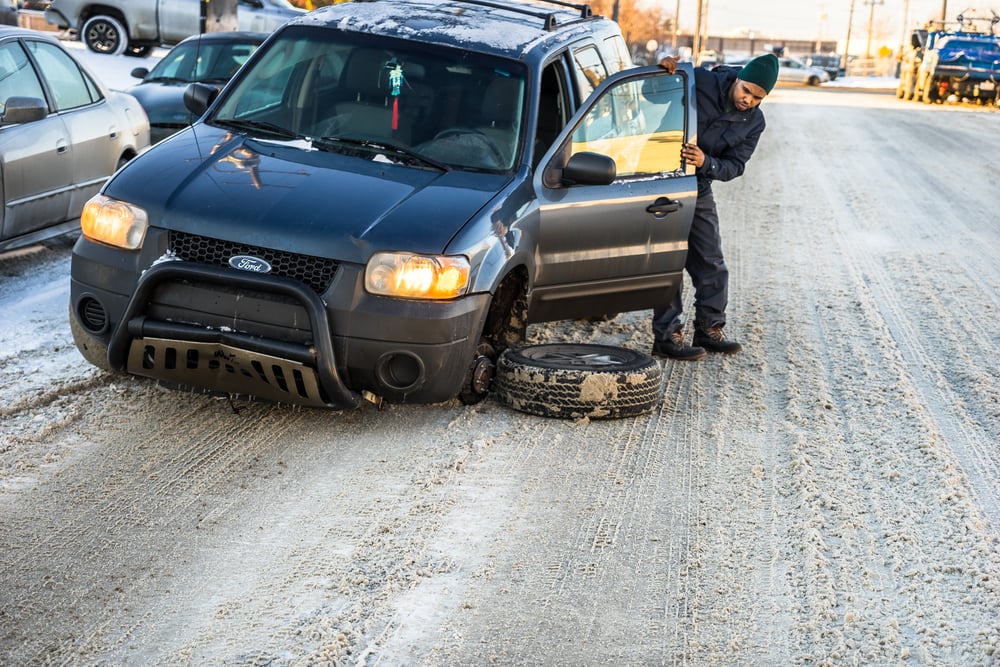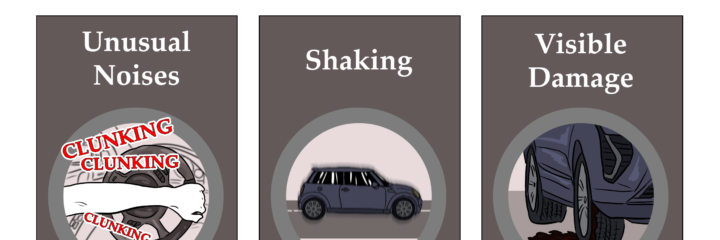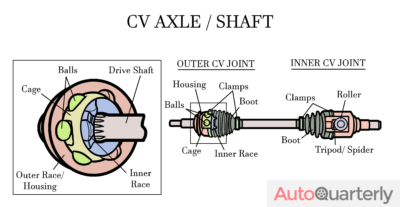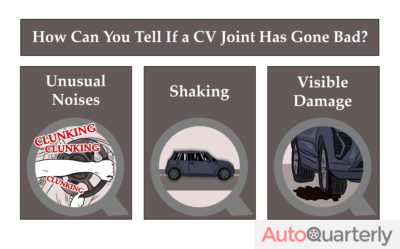Anytime your car makes funny noises or behaves unusually, it’s usually an annoying sign that something is about to go wrong. It is especially irritating when the problem is with drivetrain components, as every thump or clunk gets directly translated from the wheels to the cabin.
When it comes to drivetrain problems, one of the most common culprits is the CV joint. A bad CV joint can make your car feel unpredictable, or make noises that will have the entire parking lot staring in your direction. Those noises are a warning for big problems to come.
The good news is that fixing a CV joint is straightforward. It’s something that anyone comfortable swinging a wrench can accomplish. However, if you do have to take it to a mechanic, you won’t break the bank completely.
What Is a CV Joint?
A car needs a way to get the power from the engine to the wheels. In front-wheel-drive cars, most all-wheel-drive cars and some rear-wheel-drive cars, the final shaft between the motor and the wheels is called a constant-velocity (or CV) axle, also known as a half shaft.
A CV joint is a unique, complicated set of ball bearings, splines, and metal housings that allow the CV axle to continue to transfer power to the wheels as the wheels turn and bounce up and down on the road.
What Causes CV Joints to Break Down?
The CV axle has a lot of moving parts that need lubrication. The smaller moving parts sit inside a flexible rubber cone that holds a bunch of grease. These boots, sometimes called CV gaiters, make sure that the moving pieces have a good lubricant supply and have protection from the elements.
Like any complicated moving part, CV joints will wear down over time. Lack of lubrication can cause them to fail much faster, so it is common for damaged boots to be directly related to bad CV joints.
How Can You Tell If a CV Joint Has Gone Bad?
A CV joint is an integral part of making your car move, so there are many symptoms when one goes bad. The first symptom, as is the case with most car issues, is a feeling you get while driving that something isn’t right. It could be a strange jolt while turning into a parking lot, or an unusual noise while backing out of a driveway.
You know your car better than anyone else. If you’re feeling feedback through the steering wheel or vibrations that become more intense while accelerating, this might be a sign that something is wrong. If you suspect a bad CV joint, bring your car to a mechanic or check for these three things.
Unusual Noises
A broken CV joint will protest if you ask it to work too hard. You will hear the protesting in the form of a rhythmic clunking. The noise will usually be the loudest and most noticeable while you turn, since turning puts extra load on the joint.
Turning is also how you will be able to tell which CV joint is complaining. If you turn hard to the left and the noise gets much louder, it means the left joint is the culprit. If you turn hard to the right and the noise gets louder, it’s time to replace the one on the right.
The other telltale noise that a CV joint will make is a loud knock, usually just as the car starts to move. When the joint wears out, it has extra space to move around and collide with other metal objects. Often, those collisions occur just as the wheels begin to move. The vehicle will also lurch slightly as the joint aligns itself, a sensation you will feel in the driver’s seat.
Shaking
If you drive along a smooth road and the car tries to rattle your teeth out, you have another symptom of a bad CV joint. Under normal circumstances, the spinning axle applies power to the wheels smoothly. Everything is supposed to be tight and well greased.
When things get too loose, they begin to flop around and transfer power inconsistently. Imagine pushing a shopping cart that has one lousy wheel: that is how your car will behave if the CV joint is damaged.
Visible Damage
Grease and oil belong inside reservoirs and on moving parts, not on your driveway. If you notice that oil or grease is pooling near or on your tires where you park, you should inspect the CV boots. The rubber can tear or get pushed back, causing the grease to leak out.
While a damaged boot is not a direct symptom of a bad joint, it is an indicator that the CV joint has been operating without grease for some time. A CV joint will wear out very quickly if it does not have lubrication.
Other visual damage that you can look for concerns the alignment of the axle. The axle should form a straight line between the source and the wheel hub. Any kink is a sign that a joint has failed, and you should replace it.

Is It Dangerous to Drive With a Bad CV Joint?
The short answer is yes. A damaged joint will get worse and worse until it fails. You might be able to get another thousand miles before that happens, or you might only have a few minutes. It depends on the construction of your car and how bad the damage is.
You will become a danger to yourself and others on the road if it fails while you are driving around. A broken joint will cause you to lose power or can cause a wheel to seize. A locked wheel may cause you to slide into a wall or slide into other traffic.
Fortunately, replacing the joint is a straightforward process. Any mechanic’s shop and many home mechanics will have the tools necessary to perform the repair.
How Much Does It Cost to Replace a CV Joint?
Even though the CV joint itself is the likely culprit, it’s easier and probably cheaper to replace the entire axle. The difference in cost between the axle and the joint is small, and you have to remove the shaft no matter what to get to the joint.
To illustrate this, let’s look at a Honda Civic. Civics are one of the most popular cars around the world, so chances are there is one on the road right now in need of a new half shaft. An inexpensive CV Axle replacement for the driver’s side is about $112. If you got just the joint, you could save $20, but it would cost you hours more in time.
Parts for most cars are readily available. That means you have the choice of paying a professional to do it, or doing it yourself. There are no special tools needed. You just need to be able to lift the offending corner, and enough room to be comfortable.
Replace the Axle Yourself
Should you choose to tackle the project yourself, you can expect to pay around $200. That price includes the new axle, grease to pack into the boot, and miscellaneous items like zip ties.
The only tool you may want to purchase to make your life easier is a snap ring plier. You can get the job done with a screwdriver and a hammer. However, for less than $10, you can save yourself from spending an afternoon looking for the clip that has flown off into the weeds.
If you’re comfortable working on your own car, you should be able to do this replacement yourself by following along with a video. Anyone unfamiliar with DIY repairs, on the other hand, may want to seek out professional help.
Don’t forget: when you jack up a car, make sure to set up jack stands and chock the wheels. The only thing worse than the pain of having a car fall on your arm is having to explain to your buddies why your arm is in a cast.
Take the Car to a Trusted Mechanic
Any reputable shop will be able to replace the axle if you do not have the space or tools to do it yourself.
According to estimates online, it would cost $400 to replace an axle on the Honda Civic mentioned earlier. A more complicated car may be up to $800, while a vehicle that is easier to work on can be as little as $300.
Using YourMechanic.com, you can get a ballpark estimate based on your model and location. Your local shop will be able to give you a better deal if you are willing to work with them. Mechanics survive on coffee and donuts, a few dollars in breakfast can net you some good karma. Good karma translates to real savings.
Should You Replace Both Axles at Once?
Cars with CV axles have at least two of them, one per drive wheel. It is unnecessary to replace both sides at the same time, and there is very little time saved doing them both at once compared to doing them one at a time. That means the price for doing both is simply double the amount for doing one, at about $300-$400 if you do it yourself and $600-$1200 if you let a shop do it.
The only consideration when replacing one vs. both is the condition of the car. If one part has worn out due to long term use, other parts are likely equally worn. That makes replacing both a good way to protect against having to do the process later.
A Final Note
The CV axle and joint are essential components of any working car. If you don’t feel comfortable diagnosing the problem, there is no shame in getting a second opinion. No one will ever fault you for shopping around and making sure your car drives as nice as possible.
Whether you choose to take it to a mechanic or wrench on the car yourself, make sure to take care of the issue as soon as possible. Confidence and safety are the most essential things when operating a vehicle on public roads. A broken CV joint is not safe and does not inspire confidence. You will have a much healthier state of mind knowing the problem is solved, and so will the other drivers on the road.




